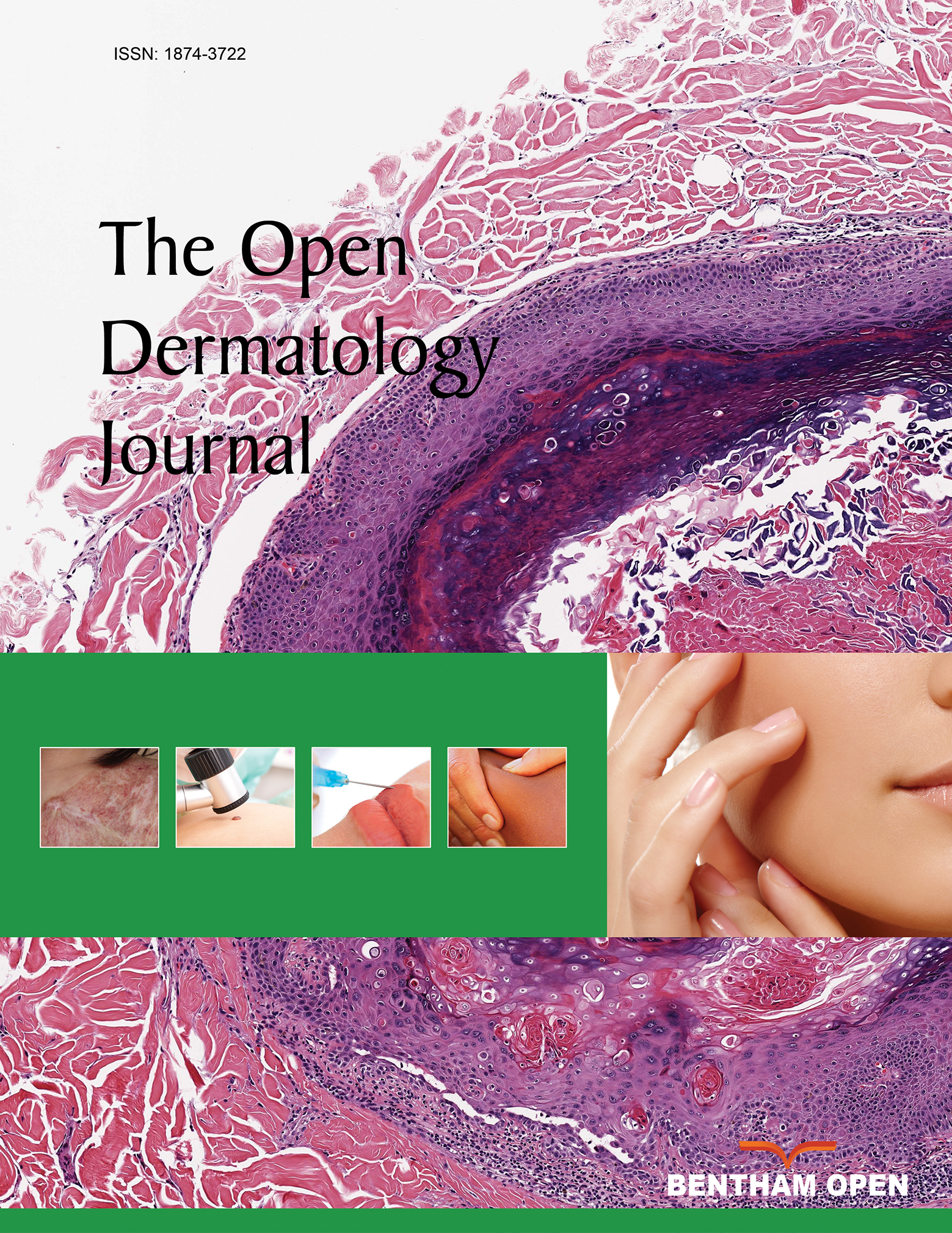All published articles of this journal are available on ScienceDirect.
Stretching the Truth: Analyzing Pregnancy Stretch Mark Recommendations on Social Media
Abstract
Background
Striae gravidarum (SG) is a common outcome of pregnancy, often leading to psychosocial distress. TikTok has become a popular source for SG prevention and treatment advice, but the scientific validity of this content remains unclear.
Methods
A cross-sectional analysis of the 100 most-liked TikTok videos on pregnancy stretch marks was performed. Data on engagement, content source, focus, and SG management recommendations were collected.
Results
The majority of the TikTok videos in the study featured personal anecdotes from social media influencers. Oil mixtures and cocoa butter were frequently recommended for SG prevention despite lacking efficacy. For existing SG, retinoids were the most mentioned treatment. Overall, non-evidence-based approaches dominated both the prevention and treatment recommendations in these videos.
Conclusion
Most SG-related TikTok content lacks a scientific basis, which may contribute to the spread of misinformation. There is a need for further research on SG, and healthcare professionals should prioritize promoting accurate, evidence-based content on social media to improve understanding and management of SG.
1. INTRODUCTION
Pregnancy is a time of significant physiological change, and many individuals seek advice on how to manage these effects. One common concern is the development of striae gravidarum (SG), or pregnancy stretch marks, which often appear on the abdomen, breasts, hips, and thighs and affect up to 90% of pregnant individuals [1]. Although SG are not life-threatening, they can negatively impact quality of life [2]. With the rise of social media, particularly TikTok, there has been a surge in content focused on the prevention and management of these marks.
TikTok, known for its short, algorithm-driven videos, has rapidly gained over 1 billion users across 150 countries, surpassing both Facebook and Instagram in downloads and usage time [3, 4]. This platform’s reach and popularity have made it a prominent source of information across various topics, including health and wellness. A recent survey revealed that many women aged 18 to 29 obtain health information on this platform, either by actively seeking it or encountering it unintentionally [5]. This demographic is especially likely to be exposed to pregnancy-related skincare content.
However, the credibility of TikTok content varies widely. While some TikTok videos are created by healthcare professionals who emphasize evidence-based recommendations, others are produced by influencers or creators with varying expertise [6]. This inconsistency in content sources raises concerns about the reliability of the information presented, as viewers may encounter advice that is not only inaccurate but potentially harmful. This potential for misinformation could influence viewers’ practices in SG prevention and treatment.
This study evaluates the messaging surrounding SG content on TikTok. Specifically, it analyzes the types of advice offered, assesses the credibility of the sources and recommendations, and examines engagement levels. The findings aim to offer insights into how effectively this platform educates and supports pregnant individuals in managing SG, while also enhancing understanding of social media’s role in health education. Additionally, the study aims to inform healthcare professionals and content creators, encouraging them to deliver accurate and valuable information to their audiences.
2. MATERIALS AND METHODS
A cross-sectional study was conducted on TikTok on August 10, 2024, and August 11, 2024. The search term “pregnancy stretch marks” was entered, and results were sorted by like count. To focus on the most engaging and influential content, the top 100 most-liked videos were selected for analysis. For each video, the posting date, along with the number of views, likes, comments, saves, and shares were recorded. Videos were categorized by creator roles (dermatologist, esthetician, social media influencer, etc.) as indicated in the video or on the creator’s profile. Whether the creator represented skin of color (Fitzpatrick skin types IV-VI) was documented, along with the primary language used in the video.
Videos were analyzed to identify key content categories (personal experiences, prevention tips, treatment strategies, body positivity, educational takeaways, humor, sponsored content, etc.), with each video fitting into one or more categories. When prevention or treatment advice was provided, all products or ingredients mentioned were documented. Any references to factors contributing to the development of SG, such as genetics, were also noted.
3. RESULTS
3.1. Engagement Metrics
The 100 most-liked TikTok videos related to pregnancy stretch marks were posted between June 2020 to July 2024. Altogether, they received over 87 million views and 7 million likes, among other engagement metrics (Table 1).
3.2. Creators
Social media influencers created 88% of the analyzed videos, while dermatologists contributed to only 5% of the popular SG TikTok content. Other creators included estheticians, pharmacists, and skincare companies (Fig. 1). In total, 95% of the videos were in English, while 2% were in Spanish, 2% in Indonesian, and 1% in Filipino. Only 14% of content creators represented skin of color.
3.3. Content Categories
Personal experiences were the most common content focus, followed by prevention tips and body positivity (Fig. 2). Sponsored content, including paid partnerships and advertisements, appeared in 13 videos. Only one video focused solely on education without providing personal experiences or SG management advice.
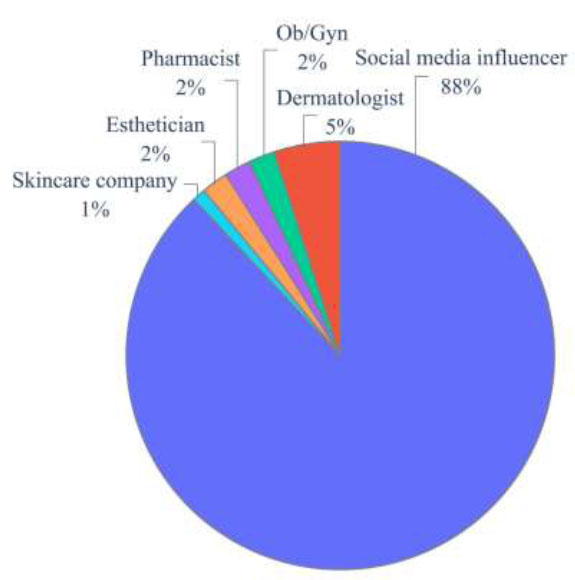
Relative proportion of content sources in the top 100 most-liked TikTok videos on SG.
3.4. Prevention and Treatment Advice
Bio-oil Skincare oil and Palmer’s Cocoa Butter Formula Products were the top-recommended branded products for preventing pregnancy stretch marks (Fig. 3). Commonly mentioned preventative ingredients in generic or homemade products included shea butter, hyaluronic acid, and coconut oil (Fig. 4). Preventative practices like dry brushing, avoiding skin scratching, and staying hydrated were each mentioned in two videos. For treating existing pregnancy stretch marks, retinoids were the most frequently mentioned, followed by microneedling (Fig. 5). The role of genetics in the development of SG was acknowledged in 21% of videos, and the rate of skin stretching was noted in 1% of videos.
| Engagement Metric | Total Count |
|---|---|
| Total Likes | 7,092,525 |
| Total Comments | 32,832 |
| Total Saves | 1,701,225 |
| Total Shares | 203,486 |
| Total Views | 87,504,500 |
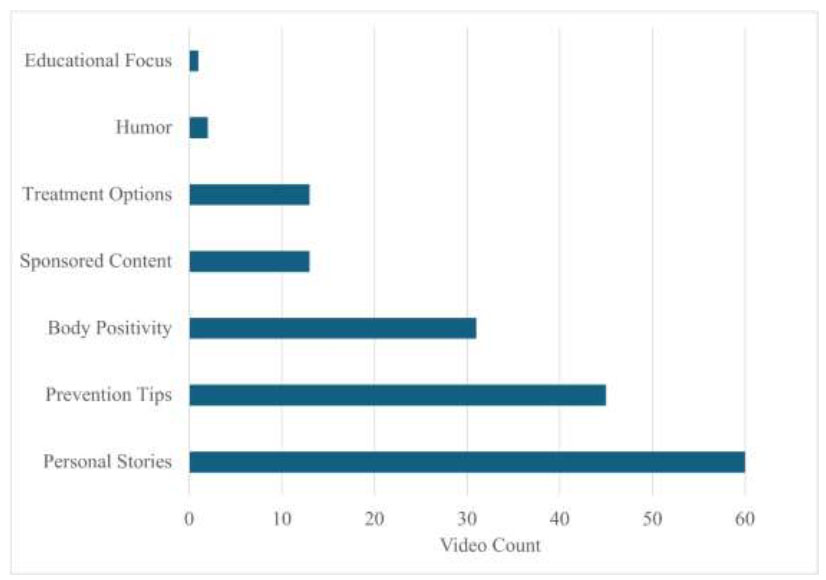
Content categories (non-mutually exclusive) of the top 100 most-liked TikTok videos on SG.
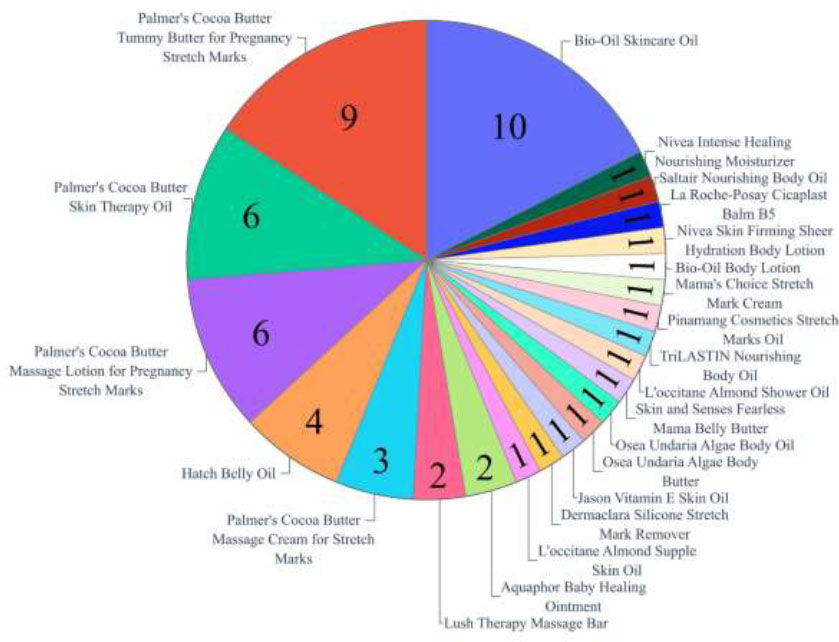
Distribution of pregnancy stretch mark prevention products recommended in popular TikTok videos on SG, with the number inside each slice indicating how many videos mentioned each product.
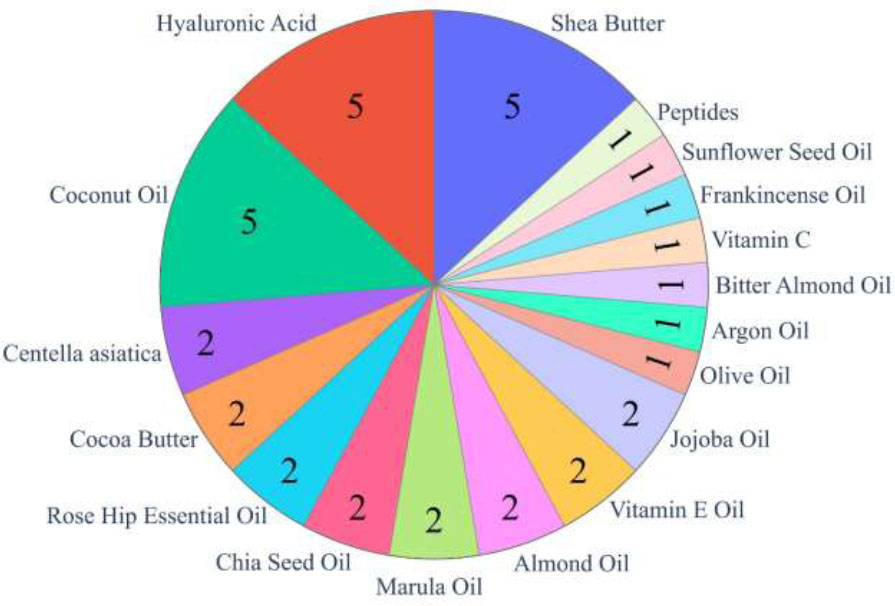
Distribution of pregnancy stretch mark prevention ingredients recommended in popular TikTok videos on SG, with the number inside each slice indicating how many videos mentioned each ingredient.
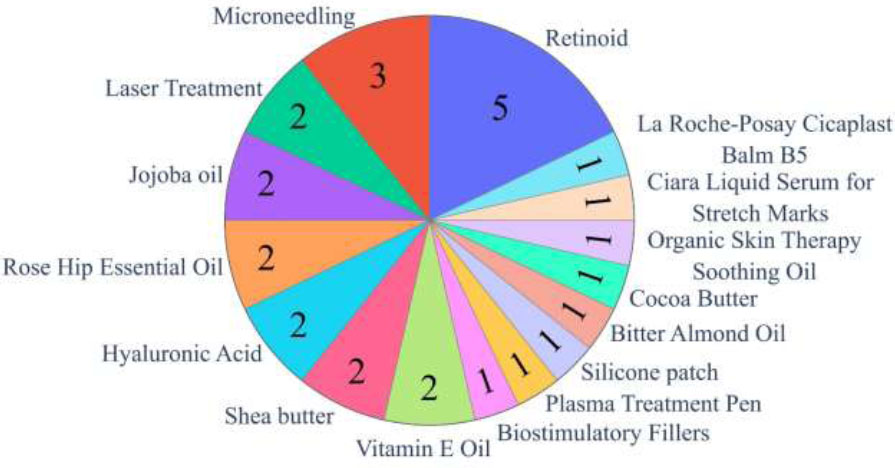
Distribution of pregnancy stretch mark treatment products, ingredients, and procedures recommended in popular TikTok videos on SG, with the number inside each slice indicating how many videos mentioned each treatment method.
4. DISCUSSION
In addition to causing physical changes, SG are associated with significant psychosocial burden and decreased quality of life [2]. Given these impacts and the rise of social media, platforms like TikTok have emerged as popular spaces for individuals to seek advice on the prevention and treatment of SG. Our cross-sectional study of the 100 most-liked TikTok videos on this topic revealed a total view count exceeding 87 million, with over 9 million interactions: likes, comments, saves, and shares. This substantial engagement suggests the potential of TikTok as an informational resource for SG management.
Our analysis indicated an imbalance in the types of content creators contributing to SG-related content on TikTok. Social media influencers accounted for 88% of the content landscape, while dermatologists were involved in only 5% of the most popular content. This disparity may explain why personal stories were identified as the most prevalent content type, whereas only one video focused purely on education. Body positivity was also a frequently featured theme. While personal stories and body positivity resonate with viewers, the limited diversity among content creators restricts the range of experiences and perspectives shared. Notably, only 14% of content creators represented skin of color, potentially fostering unrealistic expectations about how SG manifests in these skin tones. Prior research has similarly demonstrated the shortage of dermatologist-driven, skin-of-color dermatology content on social media [7-10].
Despite the limited involvement of dermatologists, prevention tips and treatment options were commonly discussed in the content. Oil blends infused with vitamins and plant extracts, as well as cocoa butter formulations, were the most popular SG prevention recommendations. However, a systematic literature review indicates that most preventive strategies for SG lack strong evidence from large, randomized studies. Only Centella asiatica extract, specifically mentioned in just 2 videos, hyaluronic acid, recommended in 5 videos, and daily massages showed some promise, though further studies are necessary [11]. In contrast, widely recommended ingredients like almond oil, olive oil, and cocoa butter, which were mentioned in over 25 videos, have not been shown to significantly decrease SG incidence compared with placebo [11]. This highlights a gap between popular social media recommendations and strategies supported by current evidence.
These understudied methods may give the false impression of being effective for individuals without a predisposition for developing SG. The etiology of SG remains unclear, with contributing factors such as hormonal changes during pregnancy and risk factors including young maternal age and a family history of SG [12, 13]. Conflicting reports exist regarding the role of the mechanical tension from skin stretching in the development of SG, as seen with increased pre-pregnancy weight, pre-delivery weight, and birth weight [1, 2]. In our study, the role of genetics in the development of SG was acknowledged in 21% of videos, and 1% mentioned the rate of skin stretching. This limited emphasis on individual predispositions oversimplifies the complexity of SG development, potentially leading viewers to believe that prevention is universally achievable.
Regarding treatment options for existing SG, although the majority of TikTok videos analyzed promoted treatments lacking sufficient evidence, the most frequently recommended treatment methods were retinoids, microneedling, and other cosmetic procedures. According to a systematic literature review, topical tretinoin and non-ablative fractional lasers have shown some efficacy in treating SG [11]. Additionally, microneedling has demonstrated effectiveness for nongestational striae, suggesting its potential for treating SG, especially when combined with platelet-rich plasma treatment or laser treatments [11, 14]. Although more research is necessary, emphasizing scientifically supported methods like these could better guide individuals seeking effective SG treatments.
Overall, many of the prevention and treatment methods mentioned in the TikTok videos analyzed in our study, including 13 videos featuring sponsored content, lack scientific validation and proven clinical effectiveness, potentially creating unrealistic expectations and further contributing to the psychosocial burden of SG. Additionally, these methods carry various financial costs and health risks [15]. Beyond social media recommendations, there remains a general lack of research and effective options for the prevention and treatment of SG. These findings underscore the need for further research on the etiology and management of SG, along with more accurate social media content, to improve understanding and set realistic expectations about this common condition.
One limitation of our study is the influence of TikTok’s personalized algorithm, which tailors content to each individual user. As a result, although videos were sorted by like count, the 100 most-liked videos analyzed may not reflect the content other users encounter, potentially limiting the generalizability of our findings. The exact mechanisms by which TikTok’s algorithm promotes certain videos remain unclear, motivating our study to explore the types of videos the algorithm appears to amplify in relation to SG prevention and treatment. While our study offers initial insights into these patterns, further research is needed to understand how social media algorithms shape the dissemination of health-related information.
CONCLUSION
This study reveals that many prevention and treatment methods for SG on TikTok are not evidence-based, potentially fostering unrealistic expectations for pregnant individuals. The predominance of social media influencers, limited involvement of dermatologists, and prevalence of sponsored content raise concerns about the reliability of the information shared. Although a few SG prevention methods, like Centella asiatica and hyaluronic acid, show promise, most recommendations lack strong clinical support. To address the psychosocial impact of SG and minimize the risks of unproven treatments, it is important for healthcare professionals to provide scientifically validated content and ensure it reaches a wide audience. Further research on the etiology and management of SG is needed to guide effective prevention and treatment.
AUTHORS’ CONTRIBUTIONS
It is hereby acknowledged that all authors have accepted responsibility for the manuscript's content and consented to its submission. They have meticulously reviewed all results and unanimously approved the final version of the manuscript.
ABBREVIATION
| SG | = Striae gravidarum |
AVAILABILITY OF DATA AND MATERIALS
All the data and supporting information are provided within the article.
CONFLICT OF INTEREST
The authors declare no financial interests, affiliations, or conflicts of interest.
ACKNOWLEDGEMENTS
Declared none.
DECLARATION OF GENERATIVE AI AND AI-ASSISTED TECHNOLOGIES IN THE WRITING PROCESS
During the preparation of this work the authors used ChatGPT for language editing. Following the use of this tool, the authors reviewed and edited the content thoroughly and hereby declare full responsibility for the authenticity of the contents of this publication.

